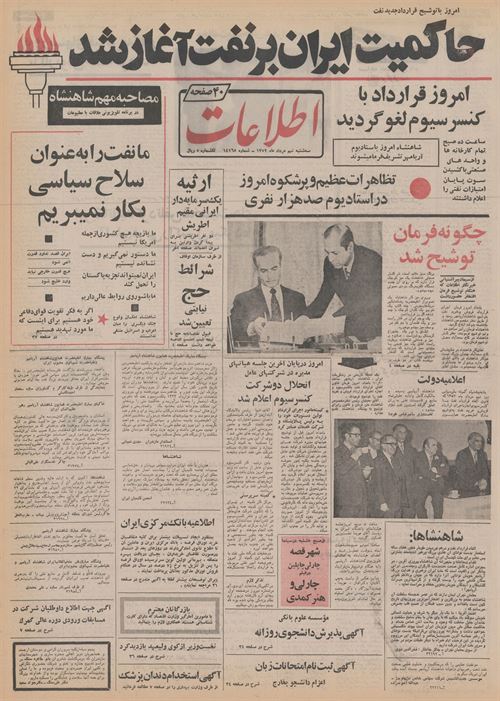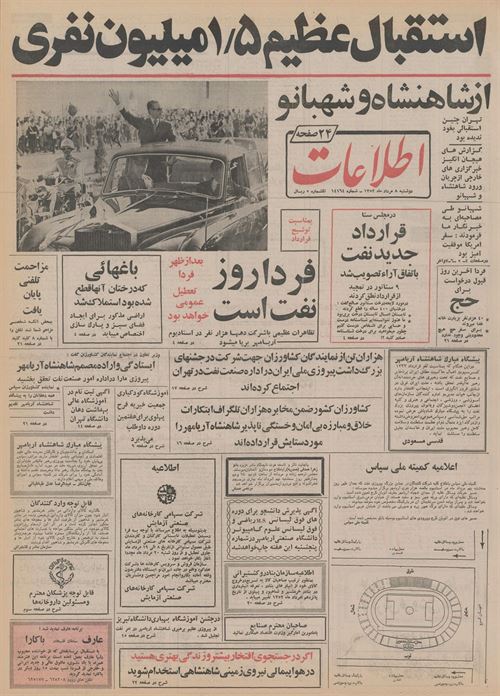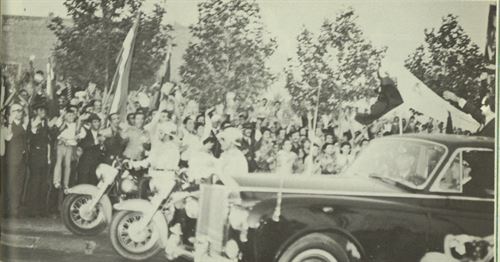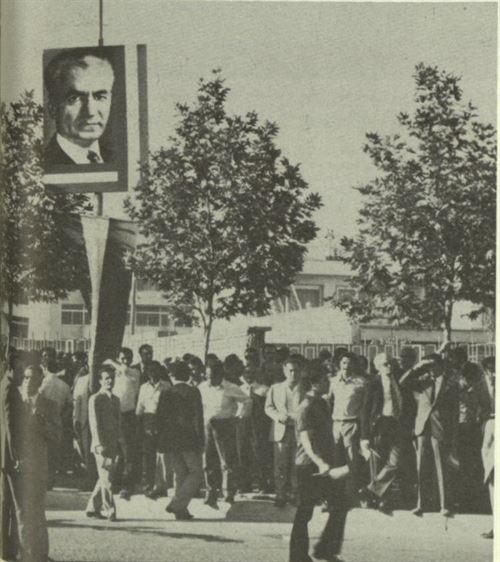The Day Iranian Oil Really Became National
Monday, August 31, 2020
By Shadi Marefati
Iran had not gotten over the 1953 coup d'état when the news of the Consortium Agreement got out. On the very same days that Dr. Mossadegh was serving his time in a military prison, word got out of negotiations with a consortium of oil majors headed by Royal Dutch Shell. It soon became clear that the nationalization of the oil industry was nothing more than a law pleasing to the eye, and now the Consortium had replaced BP to overtake the lion’s share of Iran's oil riches. The Consortium Agreement in the early years was able to reopen the Abadan refinery, which had been closed after the expropriation of the Anglo-Persian Oil Company. However, it did not take the Shah too long to regret having concluded the agreement.
He dreamed of a great Persian civilization to turn Iran into the largest oil producer in the world, on par with the United States and the Soviet Union. He used the path of development as a lever to establish himself as a strongman in the Middle East and the Persian Gulf region. Indeed, the Shah took the rift caused by the sudden death of Gamal Abdel Nasser and the disputes among the Persian Gulf littoral states as well as their war with Israel as an opportunity to make Iran stronger than ever. In one instance, he initiated formation of an integrated organization of oil exporters, the Organization of the Petroleum Exporting Countries (OPEC), which was finally established in the mid-1960s with several oil-exporting countries as founding members, like Venezuela, Iraq and Iran. The Shah's main concern in the years between 1966 and 1973 was to bolster Iran and terminate the Consortium Agreement; which finally happened in the Saint Maurice negotiations in February 1973.
Year of Oil
Supply shortage and outrageous demand doubled crude oil prices in the summer of 1973. Both Iran and Saudi Arabia took advantage of a bullish oil market by controlling their output, which greatly reduced the power of the Consortium and Saudi Aramco. Meanwhile, in Libya, Gaddafi revoked the contracts and patents of all the companies operating in his country. This meant that oil prices were now more affected by supply than the consumer demand.
According to Alinaghi Alikhani, expounding on Alam’s diaries, the year 1973 should be called the “Year of Oil:” "The rapid growth of the global economy two decades ago and the growing demand for fuel, turned the buyer of the oil market into a seller in the market. This had led to a fundamental change in the ownership of oil producing companies and the price of petroleum products."
As the balance of economic power shifted, so did the political balance. Companies had to follow suit of the policies of the producing countries, even to the disadvantage of their own states. Now, the consuming countries had no choice but to actively enter into the process of obtaining sufficient reserves at achievable prices, a process which required a political link with the producing countries. Oil, which was originally a purely commercial matter, later became a political necessity; a state affair, first in producing countries and then in consuming countries.
The first test of this new balance of power was the beginning of the October War. The same day, the OPEC summit was held in Vienna, which resulted in a Western oil embargo. Arab producers boycotted Western countries in defense of Palestine; a move Tehran refused to endorse. As a result of the embargo, more than five million barrels of oil was cut out of the market, creating a major supply gap that Iran tried to offset by fully opening its oil spigots to flood the market.
Agreement Abolished
Dr. Parviz Mina, the then-director of international affairs of the National Iranian Oil Company, one of the most prominent experts in international oil affairs in Iran, casts another look at this agreement in his book, "Transformation of Iran's Oil Industry: An Inside Look."
"In the early 1970s, Iran and the Shah himself officially gave an ultimatum to the Consortium, saying that if they refused to overhaul the terms of the 1954 Agreement and sign a new one instead, the Consortium Agreement would be terminated at the end of the initial twenty-five-year period, i.e. by 1979, and the period would not be extended,” wrote Dr. Mina in his book. “Following this warning, representatives of the Consortium member companies, fully aware of the stance of the National Iranian Oil Company on the terms and conditions to be revised, visited the Shah several times in the winter of 1972 in St. Maurice, and in the last meeting, presented the Shah with a treaty containing the terms and conditions, which is known as the St. Maurice Document. After the Shah's return to Iran, negotiations between the National Oil Company and representatives of the consortium to prepare a new contract began in early 1973. At that time, I was given the chairmanship of the delegation of the National Oil Company in the negotiations with the Consortium. Dr. Reza Fallah also participated in these negotiations as an observer. These negotiations lasted for several months, and a new contract, called the Sales and Purchase Agreement, was signed on June 31, 1973, and became law after it received the approval of the two legislative bodies (the Parliament and the Senate of Iran) on July 31, 1973."
According to this agreement, the implementation date of which was set for March 21, 1973 and its duration was twenty years, the National Iranian Oil Company, in addition to the absolute ownership of oil facilities and reserves, had full control of oil industry operations in the field of contract, including exploration, development, investment, production, refining and transportation of crude oil, gas, and petroleum products, and the Consortium became only oil buyers and privileged customers of the National Oil Company.
Image of the front page of the Ettela’at Daily on July 30, 1973
Iran Oil Exploration and Production Company and Iran Oil Refining Company were both dissolved and were replaced by a non-profit company called Oil Services Company by the Consortium. During the first five years of the Agreement, the company was obliged to provide the National Oil Company with the technical services required it in the oil-rich areas, and all operational plans and budgets of this service company were implemented with the approval of the National Oil Company.
Of the total crude oil output under the contract, the National Oil Company (NOC) would take the amount it needed for domestic consumption and that required for its independent export, which began at 200,000 barrels per day in 1973 and gradually increased to 1.5 mbd by 1981, and leave the remaining output for the Consortium to export.
All necessary investments in the scope of the Agreement were on the National Iranian Oil Company, which was the owner and operator of the facilities and operations. But the Consortium companies agreed to provide 40 percent of the required capital during the first five years of the Agreement, which included extensive development plans for exploration and production operations.
In return for the investment and technical service commitments provided to the National Oil Company through the Service Company, the price of crude oil sold for export to the Consortium was calculated based on the announced price (then set by OPEC) together with a 22 cent/barrel discount.
Considering the terms and conditions set out in the new agreement for the sale and purchase of crude oil, it can be concluded that the law on nationalization of the oil industry in the true sense of the word was implemented through this agreement in 1973, which was reflected in a press conference on the occasion of the agreement by Shah. The concessions made in the new agreement and the conditions governing it were to protect Iran's interests to such an extent that the Consortium companies, after three years, i.e. from mid-1976, began to complain about the difficulty of fully fulfilling the terms of the agreement, and for the first time in the history of oil industry, the second parties to an oil agreement (i.e., members of the Consortium) requested that the first party (the Iranian government and the National Iranian Oil Company) reconsider the terms and conditions of the deal; this sparked negotiations that continued until the 1979 Revolution.
The Day Oil Became National
On May 23, 1973, the newspapers announced the conclusion of the Consortium’s negotiations and announced that according to the Shah's statements on January 26, 1973, the Consortium Agreement was terminated in April 1973 and the Crude Oil Sales Agreement was replaced for 20 years. “Likewise, the Consortium companies will buy from reliable Iranian oil industries for twenty years. According to the new agreement, the full ownership of the entire National Oil Company over all oil reserves has been established, and all operations in the oil-rich areas and running the Abadan refinery will be under absolute control of NOC."
On July 19, Amir Abbas Hoveida and Manouchehr Iqbal, CEO of the National Oil Company, appeared in the parliament. In an address. Hoveyda stated in a speech that under the new agreement, foreign companies would be cut off from oil operations and their powers would be taken over by the National Iranian Oil Company. "Oil-producing countries' relations with major oil companies for the better part of the seventy-two years since the first Middle East oil contract (the D’Arcy Agreement) was generally based on concessions, and the management of the oil industry was fully in the hands of the oil companies. These companies extracted oil in any way and in any amount they wished, and sold it at any price and wherever they wanted."
In a report which was released on July 24, Ettela’at Daily shed light on the new oil program from the perspective of the parliament’s decision and published the amount of exported oil by 1981 which was planned to increase from 300,000 barrels per day to 1.5 million barrels per day. What was highlighted in these reports was that the management of Iran's wells and refineries would be completely in the hands of the National Oil Company, and that the crude would be provided to the Consortium.
Finally, the Senate of Iran ratified cancellation of the Consortium Agreement and the permission to execute the contract for the sale and purchase of crude oil between the Iranian government and foreign companies July 30, 1973 and it came into force on July 31, 1973. According to a single article approved by the parliament: "The 1954 Consortium Agreement and its appendixes will be canceled and the government will be allowed to enforce an attached agreement for the sale and purchase of oil concluded and signed between the Imperial Government of Iran and the National Iranian Oil Company, on the one hand, and the foreign companies mentioned in the agreement, on the other hand."
Image of the front page of Ettela’at Daily on July 31, 1973
Carnival of Happiness
The deal, known as the St. Maurice Agreement, made the Shah too proud. Happiness carnivals erupted and a flood of congratulations was published in the newspapers by the guilds and the people, who rejoiced at the victory, and even a committee was formed to thank the Shah on behalf of the nation upon his return from the United States. Assadollah Alam writes in his memoirs on July 25, 1973: "... festivities and lighting have been around to celebrate the oil success in a spoony manner just like Mossadegh's affairs. Today, I was sickened by the amount of flattery in the parliament. The King of the Kinds does not really claim to be a god; he is a very great man and a true human being. We, Iranians, buttered Alexander up so much that he killed all the leaders of his army who refused to commend him."
"Iran Oil Reign Begins," Ettela'at Daily headlined, and other newspapers and the press described the day as a "turning point in the history of oil," and that is how Iranian oil really became national.
The following are some of the images of these festivities and welcome celebrations taken from the press on those days, especially the "Oil Industry Letter" published in July 1973.
Mohammad Reza Shah crossing in front of the line of oil industry employees
Oil industry employees welcoming Mohammad Reza Shah
References:
Notes of Fouad Rouhani, Editors Gholamreza Tajbakhsh and Farrokh Najmabadi, Ney Publications, 2014
Manouchehr Farmanfarmaeian, Blood and Oil: Memoirs of an Iranian Prince, Tehran: Phoenix Publications, 1998
Engineer Ghobad Fakhimi, 30 Years of Iranian Oil, from the Nationalization of Oil to the Islamic Revolution, Tehran: Mehrandish, 2008
Parviz Mina, The Evolution of the Iranian Oil Industry, An Inside Look, Interview with the Iran Studies Foundation.
Memoirs of Alam, Tehran: Ketabsar, 2013.











